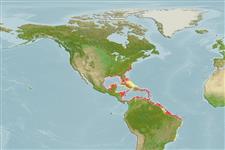Cephalopoda |
Myopsida |
Loliginidae
Environment: milieu / climate zone / Mức độ sâu / distribution range
Sinh thái học
; Thuộc về nước lợ; Mức độ sâu 0 - 20 m (Tài liệu tham khảo 275). Tropical; 15°C - 32°C (Tài liệu tham khảo 275); 40°N - 38°S, 99°W - 33°W (Tài liệu tham khảo 275)
Atlantic Ocean.
Length at first maturity / Bộ gần gũi / Weight / Age
Chín muồi sinh dục: Lm 5.0 range ? - ? cm Max length : 8.0 cm ML con đực/không giới tính; (Tài liệu tham khảo 275); 12 cm ML (female)
Minimum depth range from Ref. 83938. Found in inshore waters to a depth of 20 m. Can tolerate low salinities allowing it to move to estuaries during warmer temperatures. Feeds on zooplankton, small crustaceans and fishes (Ref. 843).
Life cycle and mating behavior
Chín muồi sinh dục | Sự tái sinh sản | Đẻ trứng | Eggs | Sự sinh sản | Larvae
Members of the class Cephalopoda are gonochoric. Male and female adults usually die shortly after spawning and brooding, respectively. Mating behavior: Males perform various displays to attract potential females for copulation. During copulation, male grasp the female and inserts the hectocotylus into the female's mantle cavity where fertilization usually occurs. Life cycle: Embryos hatch into planktonic stage and live for some time before they grow larger and take up a benthic existence as adults.
Roper, C.F.E., M.J. Sweeney and C.E. Nauen 1984 FAO Species Catalogue. Vol. 3. Cephalopods of the world. An annotated and illustrated catalogue of species of interest to fisheries. FAO Fish. Synop. 125(3):277p. Rome: FAO. (Tài liệu tham khảo 275)
IUCN Red List Status
(Tài liệu tham khảo 130435: Version 2025-1)
CITES status (Tài liệu tham khảo 108899)
Not Evaluated
CMS (Tài liệu tham khảo 116361)
Not Evaluated
Threat to humans
Human uses
Các nghề cá: Tính thương mại; mồi: occasionally
| FishSource |
Các công cụ
Thêm thông tin
PhysiologyThành phần ô-xy
Human RelatedStamps, coins, misc.
Các nguồn internet
Estimates based on models
Preferred temperature
(Ref.
115969): 23.4 - 28.2, mean 27 (based on 579 cells).
Fishing Vulnerability
Low vulnerability (10 of 100).
